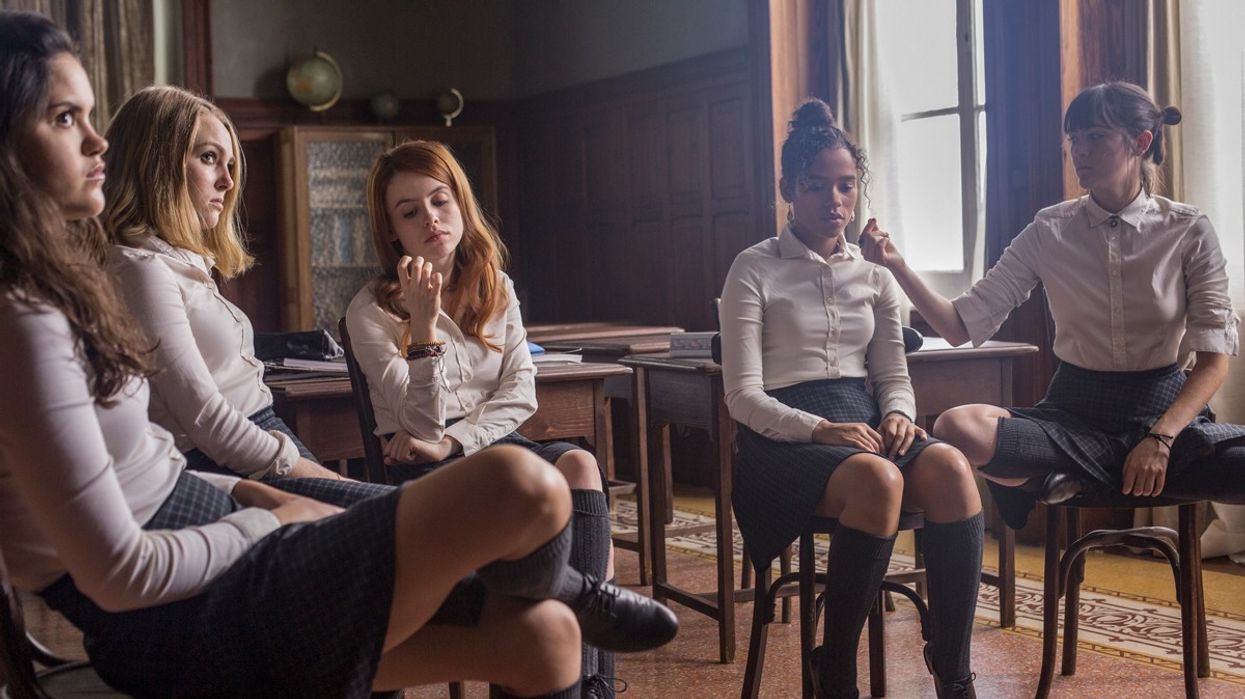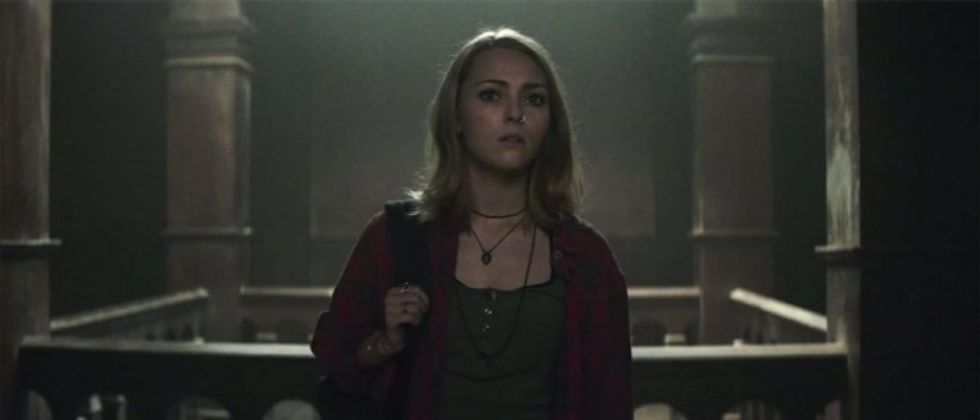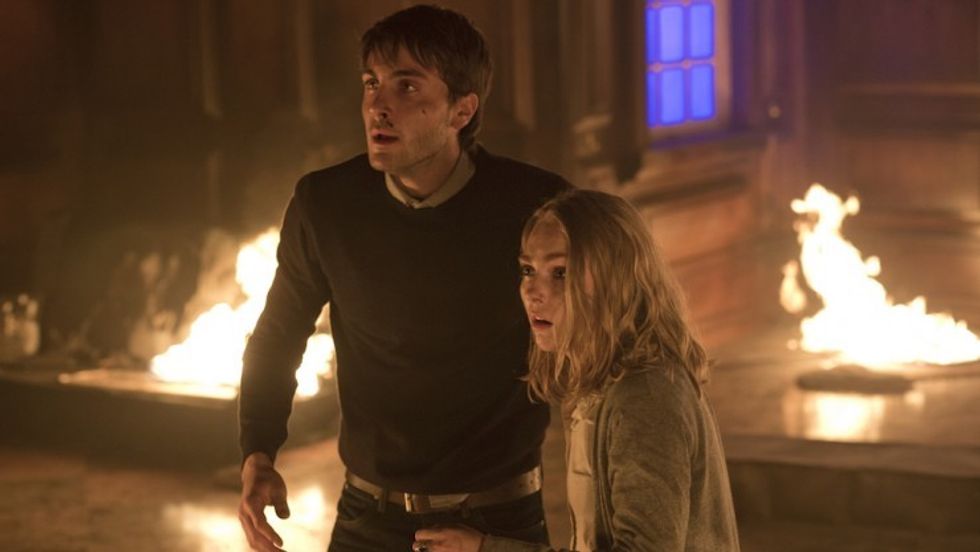'Camera Placement is Everything': 'Down a Dark Hall' DP Jarin Blaschke on Filming in the Shadows
When he was filming 'Down a Dark Hall,' DP Jarin Blaschke had a number of different lighting scenarios to consider.

Rodrigo Cortés Down a Dark Hall is both an old-fashioned story and a decidedly unorthodox one. There are many elements that may be familiar to horror movie buffs: a haunted girls school, a possession of souls, a potentially deranged host. And yet, if you dig within the story, of a young girl sent to a posh school for discipline only to find it a portal to the dark side of humanity, you'll find many idiosyncrasies which typify memorable, even ingenious films.
AnnaSophia Robb plays Kit, a young woman sent to an elite boarding school for character reform after some profoundly delinquent behavior. Once she arrives, she meets a similarly-minded set of rebels, under the strangely accented supervision of the school’s headmistress (played with scenery-nibbling greatness by Uma Thurman). The dynamic between Thurman’s chaperone and her charges is off-kilter enough to watch, but then we have the sheer mood of the film to deal with: a sort of cross between Bram Stoker’s Dracula and Dead Poets Society. As the story unfolds, you might find yourself willing to suspend belief to a greater extent than you might have felt previously—and one can’t help but attribute this in part to the cinematography.
No Film School caught up with DP Jarin Blaschke, most recently known for Robert Eggers' The Witch, about how he shot this bedevilingly complex film.
Jarin Blaschke: The Witch had a rather narrow portfolio of looks. . . two looks, really. There's a cool, soft overcast look and then there are the warm flickering firelight and candles. That's about it, save for maybe two short exterior scenes. Hall has a lot more variety as far as color and quality of light are concerned, really a whole portfolio of seasonal variations and times of day and night.
Each of these looks had to be created from scratch since we were shooting in the studio. Fortunately, this time I had the resources to attempt all these versions of window light: from hard lit summer afternoons to starker more color-separated autumn afternoons, cool overcast light, dirty dim skylights at day's end, to mixed color, western-facing twilight, to cold winter north light, to moonlight, to waning dusk mixed with warm practicals. There are also other kinds of light that don't have to do with the sun and moon. Of course, we have incandescent chandeliers and lamps, but also scenes lit by candles, lightning strikes, flashlights, cell phones, rooms on fire, emergency vehicles, stark camping lanterns, fluorescents, and for good measure, blinding supernatural light from another realm. It was a lot to keep track of and execute! Fortunately, my gaffer, Jose Luis Rodriguez, was exemplary.
For day interiors, I'm a big user of bounced light. There isn't another way I've found to diffuse lights that look nearly as natural. If you do it properly, it's the closest approximation of an actual sky. I would place a panorama of white cloth outside of all of the key windows, at least 15-feet away from the window, and 20-feet or more if we could manage it. Jose Luis introduced me to this really beautiful material they call white moulton. It has a totally matte, fluffy texture on one side. In regards to a totally sheen-free, perfect matte bounce, it puts regular bleached muslin to shame.
"Bounced light is a choice of quality over quantity, and it is ultimately very inefficient."
Blaschke: With each of our twilight interiors, I would use an array of lights to fill out most of the moulton with slightly blue-gelled light and then light a small chosen area near a horizon line with a higher intensity straw or orange (like the area of sky adjacent the set sun). As it came in the window, you'd get lovely transitions of color around the room and across the smaller palette of an actor's face.
Bounced light is a choice of quality over quantity, and it is ultimately very inefficient. Additionally, in Spain, they refuse to allow HMIs in the studio for sound reasons, so we were further limited to the output of tungsten lighting. Tungsten is another case of quality over quantity: The output is much less efficient, but the spectrum is more complete and flattering than HMI, so I didn't mind trying to make it work. However, even at 800ISO (and bouncing with an array of multiple 20ks and 10ks), we were always fighting to reach a fairly open aperture in large rooms.
Blaschke: Actually, this film was a totally new experience for me because overall, I had very little hand in devising the shots. I was hired because Rodrigo wanted a more delicate lighting palette for this particular piece, but he prefers to place the cameras himself. I'm usually involved in the holistic visual design of a film, so I initially arranged shot meetings between us in order to plan out the movie. After he humored me for the first few meetings, I realized that Rodrigo had very distinct ideas of his own about certain scenes, and for most others, it was very important to him that he had the freedom to find the shots on set. It was clearly a waste of Rodrigo's time to deliberate methods and ideas that he had already decided upon.
When I have the privilege of contributing to the shot design of films I've photographed, it grants the side benefit of completely searing the whole movie into my brain. It also helps me to plan delicate lighting around where the camera will be. With simple, subtle directional lighting, especially at the threshold of exposure, camera placement is everything; the lighting can go from sublime to muck within 15 degrees. The graphic dynamics within the frame fundamentally determine the success of the lighting and how things are contrasted and outlined. A dark object against a dark space disappears completely. Delicate backlight sheen can vanish.
"It's an invigorating part of the process for Rodrigo, and let's just say that it was a bit more stressful for me. I would play catch up as I would see cameras moving around."
Blaschke: Additionally, front light generally needs to be harder and more broken up than side light to remain dynamic, while 3/4 or sidelight on a face can look too severe without some softness and it can wrap into both eyes. What is beautifully voluptuous for one can often turn a bland indiscriminate wash for the other.
On set, Rodrigo likes to feel free with the camera(s) and is somewhat improvisational. He has a more rapid internal clock and is much more interested in rhythm and movement than precious composition or predetermined rules. The camera was always on a trackless dolly and often on a jib as well. He would communicate directly with the operator in Spanish, and once we were in, he would try things out.
It's an invigorating part of the process for Rodrigo, and let's just say that it was a bit more stressful for me. I would play catch up as I would see cameras moving around. The 8x8 bounce I set for the angle would then be washing out the new final position for the camera, or a new camera move would show a teaser that was giving extra richness to the previous shot. I was keeping busy with my eyes peeled!
NFS: We get a lot of close-ups of the characters in this film. How did you work with the actors as you were filming the movie? What kinds of discussions did you have about the way they were being shot?
Blaschke: On a technical level, AnnaSophia and Uma were particularly good at performing to the camera, even as things would shift. When it helped, I would let them know the frame size and the camera move, and they would tweak the energy and tone of the delivery for the camera and the light.
I was primarily trying out a lot of pent-up lighting ideas I've had for years, particularly in the area of twilight interiors and mixed light. However, I can't help but be generally inspired by the controlled, heightened naturalism of Roger Deakins and Emmanuel Lubezki.
Blaschke: In regards to a certain overexposed top light scene (the "spirit light"), one cinematographer I couldn't help but be conscious of is Robert Richardson and his famous overexposure. Perhaps if his films never existed, the scene would have been conceived differently. From testing, I discovered the sweet spot with the lens and the sensor where highlights look like pure white and actually start to halate without diffusion (but technically do not clip).
I had to keep a careful eye during each of the shots to keep them within 1/2 stop of total clip white. AnnaSophia is much fairer than our Spanish background players, so it was not without challenge to stay within such tight tolerances. In such a sequence, faces reached normal exposure by light bouncing off black fabric laid all over the floor and walls.
I was concerned about the "raccoon eye" effect on AnnaSophia and Uma with such hard top light, but I discovered that when a face ranges from +5.5 stops on the lit side and photographic normal on the "dark" side, you can get away with a lot in the absence of shadows.
For more information on 'Down a Dark Hall,' click here.














